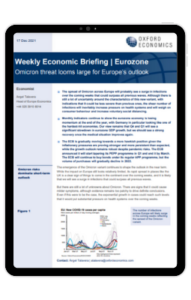Omicron threat looms large for Europe’s outlook

The spread of Omicron across Europe will probably see a surge in infections over the coming weeks that could surpass all previous waves. Although there is still a lot of uncertainty around the characteristics of this new variant, with indications that it could be less severe than previous ones, the sheer number of infections will inevitably increase pressure on health systems and will weigh on consumer behaviour and increase voluntary social distancing.
What you will learn:
- Monthly indicators continue to show the eurozone economy is losing momentum at the end of the year, with Germany in particular looking like one of the hardest-hit economies.
- Our view remains that Q4 and Q1 will see a significant slowdown in eurozone GDP growth, but we should see a strong recovery once the medical situation improves again.
- The ECB is gradually moving towards a more hawkish position given the inflationary pressures are proving stronger and more persistent than expected, while the growth outlook remains robust despite pandemic risks.
Tags:
Related research

Post
US Key Themes 2026: Exceptionalism amid fragmentation
US exceptionalism is alive and well, and that won't change in 2026.
Find Out More
Post
Global Key themes 2026: Bullish on US despite AI bubble fears
We anticipate another year of broadly steady and unexceptional global GDP growth, but with some more interesting stories running below the surface.
Find Out More